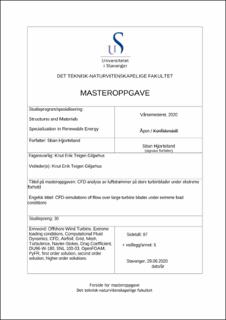| dc.description.abstract | The goal of this project is to investigate the opportunity of performing CFD-analysis of flow over a large offshore wind turbine at a high angle of attack during extreme loading conditions. At a 90° angle of attack, the drag force is at its highest, making this loading condition the most critical for the turbine blade. Little work has been published on wind turbines at a high angle of attack, making the project a relevant contributor to future research.
In simple terms, an airfoil can be considered as a cross section of a turbine blade, making it a good reference for how one can expect the aerodynamics to work and behave at high angle of attacks. Furthermore, fluid flow at a high angle of attack often results in a highly separated flow, which has been proven hard to predict with the help of first and second order solutions. Higher order solutions are introduced and investigated in the search of a solution to the expected inaccuracy. Moreover, different CFD solvers were tested for the DU96-W-180 airfoil at 90° angle of attack at a Reynolds number of 0.7⋅106. The results was then compared to already existing data in order to validate the computational setup, as well as comparing the different solvers. The results indicated that the second order solutions from OpenFOAM had problems predicting the drag coefficient accurately, as they were a bit higher than the experimental result. However, the third order solutions from PyFR was a closer match, supporting the statement of higher order solutions being better at predicting the aerodynamics at highly separated flows. In addition, the simplified results from Xfoil also showed a good ability of predicting the drag coefficient.
A full-scaled offshore wind turbine blade called SNL100-03 was modelled from scratch in Qblade. Some difficulties was encountered for the mesh generation and are described in chapter 8. Nevertheless, two different meshes were generated and simulated for three different extreme loading conditions. The flow behind the blade was considered to be similar to the flow for the DU-96-W-180 airfoil. As for the drag forces, there was a clear difference between the Fine Mesh and the Course Mesh, where the Course mesh appeared to be much more unstable in its prediction. It was also concluded that a finer mesh with a lower y+ could be achieved by using Pointwise without increasing the number of cells to a large degree, as Pointwise and snappyHexMesh has different ways of representing the geometry, resulting in CFD having a potential for solving extreme loading conditions on a full sized wind turbine blade at a high angle of attack. | en_US |
